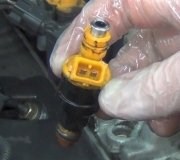There's no ground wires in the injector or ignition coil circuits, so if you grounded something, that would be what is shorted. Both circuits are grounded by the Engine Computer. It switches the grounds on for the injectors to pulse them for a few milliseconds, and it switches the grounds off for the ignition coils, individually, when they need to create the spark.
The first diagram has fuse # 24 circled. That feeds circuit F42 dark green / light green for the six injectors. The two circuits are continued on the second diagram at call outs "I" and "J". This is the circuit that has to be shorted for that fuse to blow.
If you aren't sure if the short is something you caused, another way to find this is to replace the blowing fuse with a light bulb. That will limit current flow in the circuit to safe value, and give you a visual indication of when the short is present or removed. Normally I stick a 3057 brake light bulb in place of the fuse, but for anything related to the automatic shutdown, (ASD) relay, which this is, it's better to bypass the relay instead because that relay only gets turned on for one second when you turn on the ignition switch. Obviously that is not enough time to do any testing. The relay gets turned on again during engine rotation, (cranking or running), but since the engine doesn't run, any testing would have to be done while a helper is cranking the engine. Again, not practical.
The way to do this is to install a good fuse into socket #24. Don't turn the ignition switch on or that fuse will blow again. Now, remove the ASD relay, then stick in two universal crimp-type spade terminals into the socket's terminals 30 and 87. That's if you have the common 1" cube relays. If you have the skinnier relay like the one shown on the right of the drawing, use the two terminals the arrows are pointing to.
Use a pair of small jumper wires to connect those two terminals to the light bulb. A 3057 brake light bulb has easily accessible terminals and will limit current to one amp. It can get pretty hot when it's at full brightness, so be careful where you lay the bulb.
By connecting the bulb across the relay socket, the circuit will be energized all the time. No need to turn the ignition switch on, and there won't be nearly enough current to blow the new fuse. If the short is present, the bulb will be full brightness. Now you can move wire harnesses around, unplug things, and disconnect connectors to see what removes the short from the circuit. When you find something that removes the short, the bulb will get dim or go out completely.
I just noticed they changed the relay terminal numbering, but the physical locations are the same. Use terminals 82 and 84. Two small red arrows are pointing to them in the fourth diagram.
Images (Click to make bigger)
Wednesday, November 13th, 2019 AT 5:19 PM


































